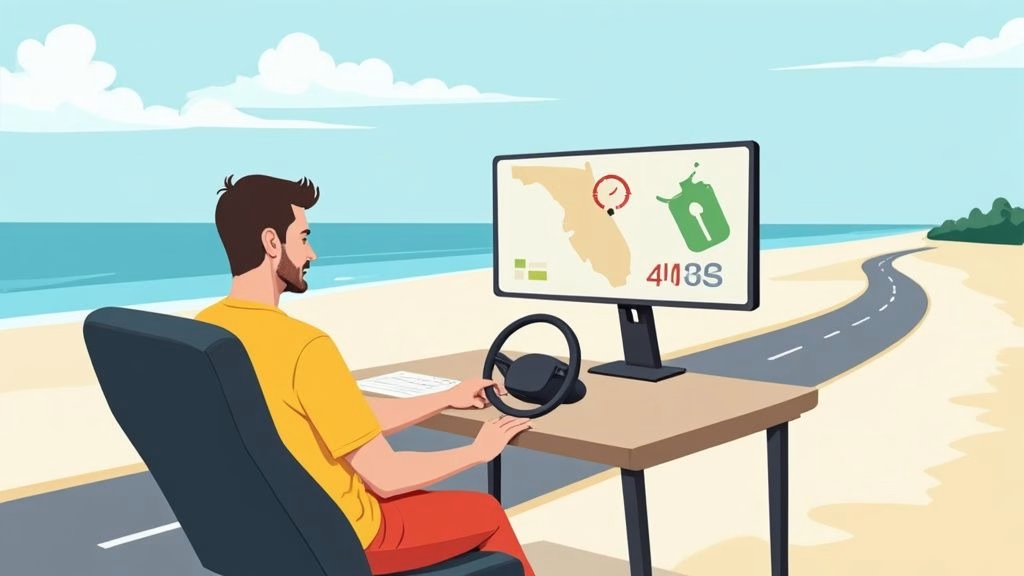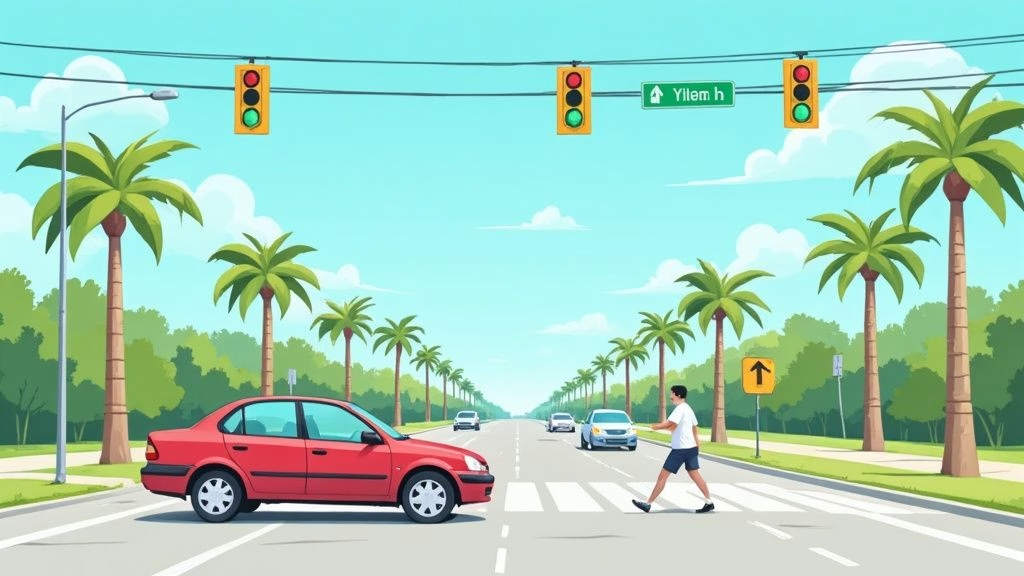Defensive driving represents a proactive approach to road safety that goes far beyond basic traffic rules. This comprehensive defensive driving definition encompasses techniques that help drivers anticipate and respond to potential hazards before they become accidents.
We at floridadetscourse.com see how proper defensive driving training transforms nervous drivers into confident, safety-focused professionals. The statistics speak volumes: defensive drivers experience 50% fewer accidents than average motorists.
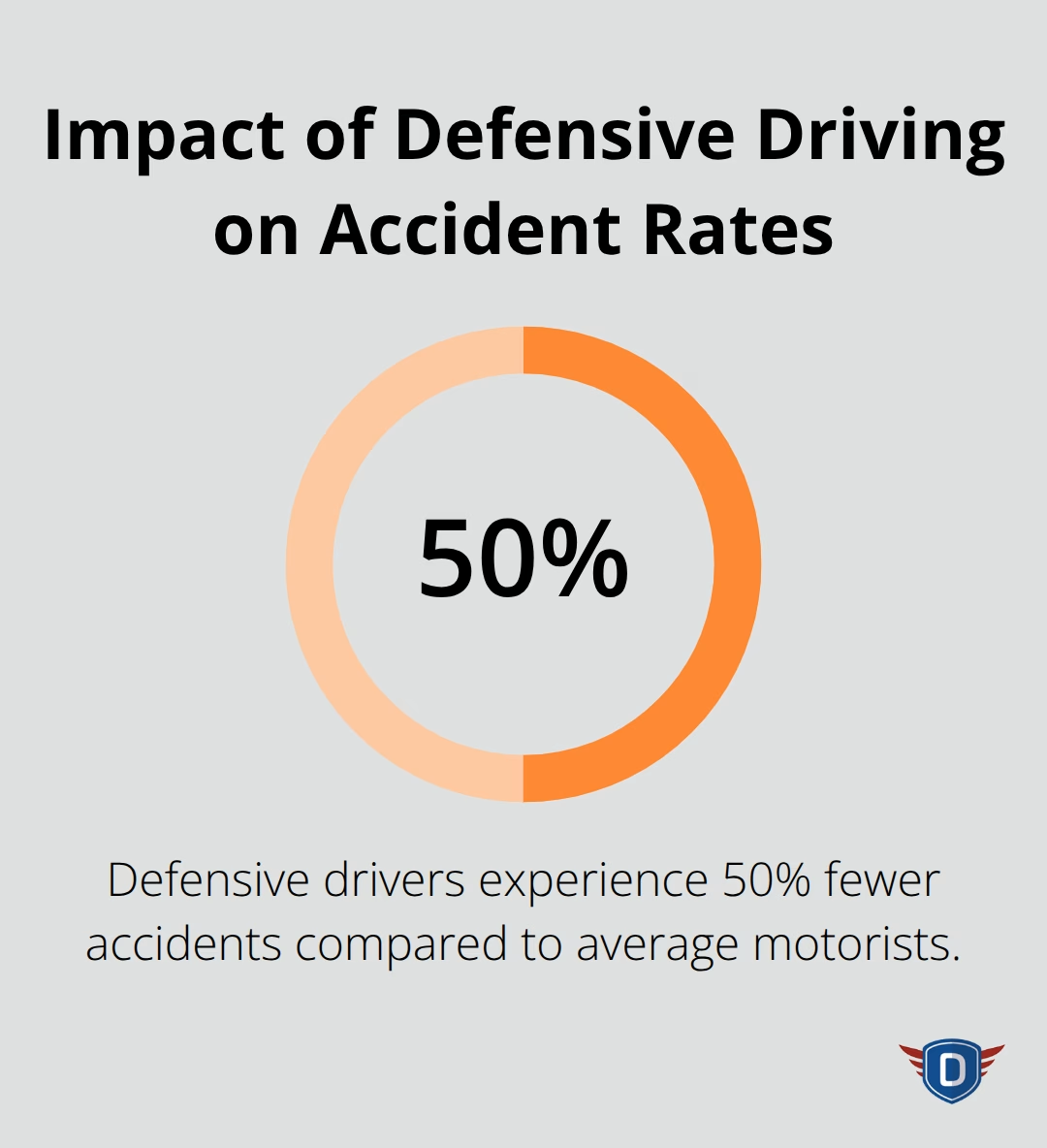
What Makes Defensive Driving Different
Core Definition and Fundamental Principles
Defensive driving means you take complete control of your safety by assuming other drivers will make mistakes. The National Highway Traffic Safety Administration confirms that human error causes 94% of fatal crashes, which means defensive drivers must compensate for everyone else’s poor decisions.
This approach requires constant scanning of your environment, maintenance of escape routes, and strict adherence to the three-second rule. The Insurance Institute for Highway Safety reports that drivers who practice defensive techniques reduce their crash risk by up to 70% compared to reactive drivers.
The Critical Difference Between Defensive and Aggressive Driving
Aggressive drivers react emotionally and take unnecessary risks, while defensive drivers plan ahead and prioritize safety over speed. The American Automobile Association found that aggressive driving contributes to 56% of fatal crashes (with tailgating, excessive speed, and lane weaving as primary factors).
Defensive drivers maintain consistent speeds, signal early, and leave adequate space between vehicles. They understand that arrival five minutes later beats not arriving at all. This mindset shift transforms driving from a competitive race into a strategic safety exercise.
How Defensive Driving Reduces Accident Risk
The National Safety Council data shows defensive driving courses reduce accident rates by 50% through systematic hazard recognition training. These techniques work because they address the root causes of crashes: inadequate following distance, poor visibility, and failure to anticipate other drivers’ actions.
Defensive drivers check blind spots twice before lane changes, reduce speed in poor weather conditions, and avoid driving during peak fatigue hours (between 2-4 AM). Insurance companies recognize this effectiveness and offer premium discounts averaging 10-15% for drivers who complete certified defensive driving programs.
These fundamental principles form the foundation for specific techniques that every driver can master. The next section explores the practical skills that transform these concepts into real-world safety benefits.
Essential Defensive Driving Techniques
The Three-Second Rule and Speed Adaptation
The three-second rule forms the backbone of defensive driving, but most drivers apply it incorrectly. Count one-thousand-one, one-thousand-two, one-thousand-three from when the vehicle ahead passes a fixed object until you reach the same point. Choose a 3-second-plus following distance to maintain proper spacing.
In poor weather conditions, extend this to six seconds minimum. Speed control means you match conditions rather than posted limits. Rain reduces tire grip by 30%, while fog cuts visibility to mere feet. Professional drivers reduce speed by 10 mph for every weather condition that compromises visibility or traction.
Systematic Hazard Recognition
Effective hazard recognition requires you to check mirrors every five to eight seconds and conduct 360-degree awareness checks before any maneuver. The Insurance Institute for Highway Safety reports that drivers who scan systematically identify hazards 2.3 seconds earlier than reactive drivers.
Focus on the area 12-15 seconds ahead of your vehicle while you maintain peripheral awareness. Watch for brake lights, turn signals, and erratic movements from other vehicles. Pedestrians who step toward crosswalks, cyclists who wobble, and motorcycles that change lanes signal potential conflicts.
The Smith System Approach
Professional truck drivers use the Smith System’s five keys: aim high in your direction, get the big picture, keep your eyes active, leave yourself an out, and make sure others see you. This behavior-based system helps drivers see, think, and react effectively, focusing on space, visibility, and awareness.
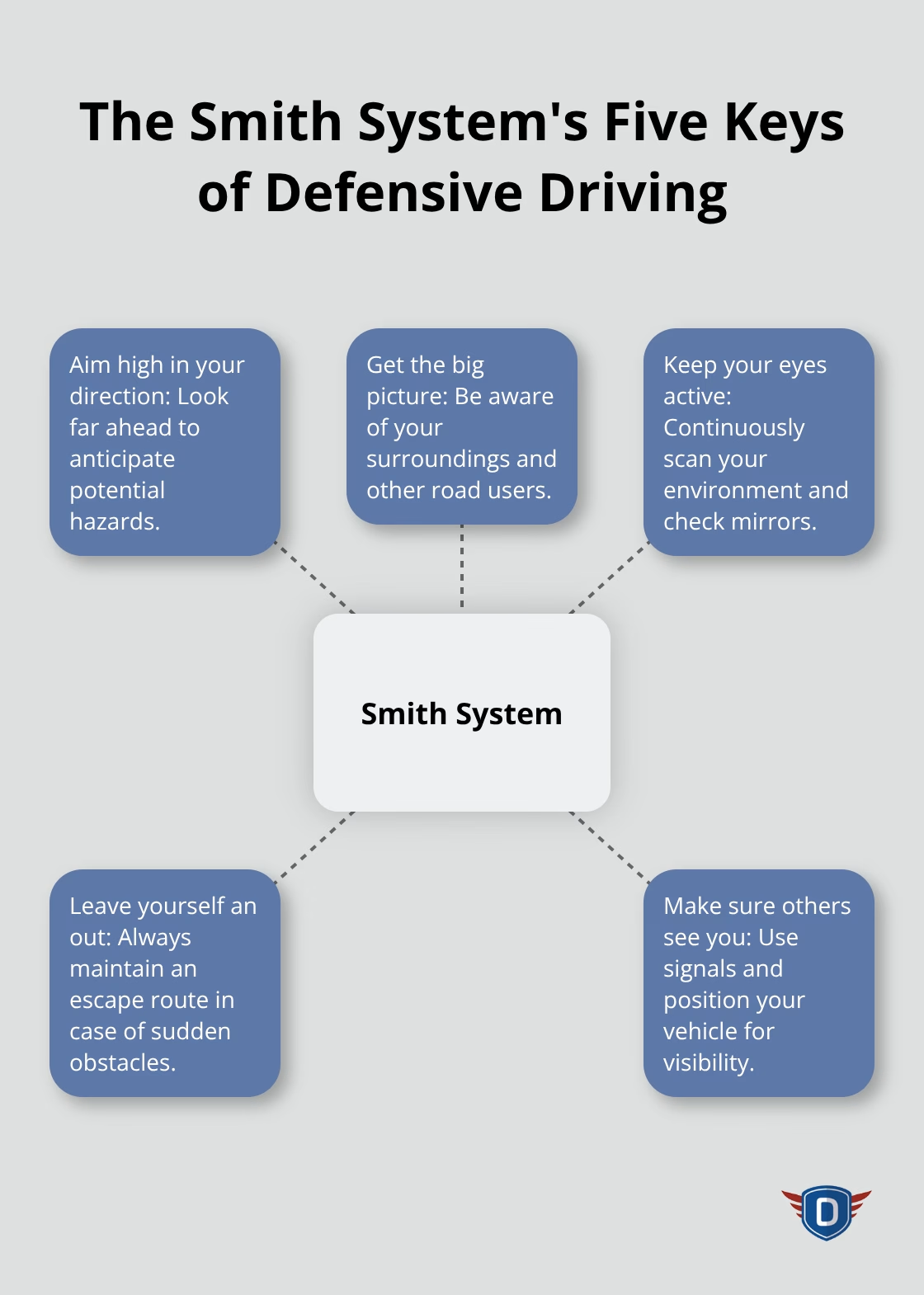
You must scan continuously rather than fixate on single objects. Check your blind spots twice before any lane change. Position yourself where you can see potential escape routes at all times.
Strategic Lane Position and Clear Communication
Position your vehicle in the center of your lane unless hazards require adjustment. Move left within your lane when you pass cyclists or parked cars, and shift right when large vehicles approach from the opposite direction.
Signal 100 feet before turns in city areas and 300 feet on highways. The Federal Motor Carrier Safety Administration found that early communication reduces lane-change accidents by 60%. Never change lanes without you check blind spots twice and confirm adequate space exists.
Maintain visibility and avoid positions alongside other vehicles. Stay out of truckers’ blind spots that extend 20 feet in front and 200 feet behind their trailers (these zones create the most dangerous road positions for passenger vehicles).
These technical skills provide the foundation for the substantial benefits that defensive drivers experience both financially and personally.
Benefits of Defensive Driving Training
Insurance Premium Reductions That Add Up
Insurance companies recognize defensive driving as risk reduction and reward it accordingly. GEICO typically offers discounts of 5% to 10% on your total premium for completing an approved defensive driving courses. Many insurance providers offer similar reductions that can result in meaningful annual savings for drivers who complete these programs.
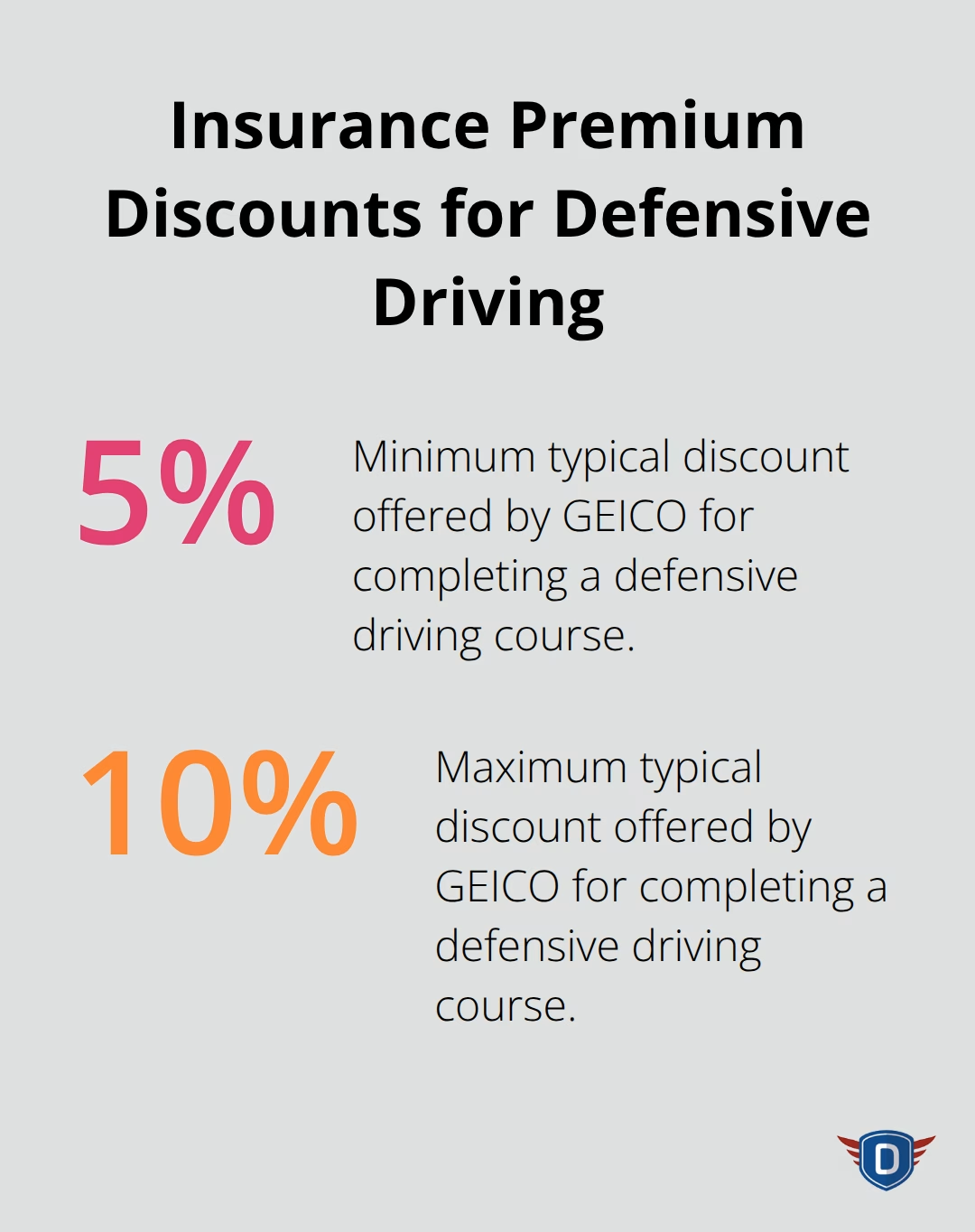
Most insurance providers require course completion every three years to maintain these discounts. Progressive and Allstate extend discounts to both liability and comprehensive coverage, which maximizes your savings. Drivers who complete defensive driving courses maintain these insurance benefits while experiencing fewer claims than untrained drivers. This combination creates compound savings that often exceed $1,000 over five years.
Measurable Safety Improvements and Accident Prevention
The Insurance Institute for Highway Safety provides comprehensive crash statistics, showing that 59% of crash fatalities in 2023 were passenger vehicle occupants, with 18% being pedestrians and 15% motorcyclists. Defensive driving training addresses the skills needed to avoid becoming part of these statistics through improved hazard recognition and response techniques.
Defensive driving courses address the leading crash causes: following too closely, inadequate surveillance, and false assumptions about other drivers’ actions. Graduates learn to identify these situations earlier than untrained drivers, which provides the reaction time needed to avoid crashes entirely. Professional drivers with defensive training consistently demonstrate better safety records than those without formal training.
Enhanced Confidence Through Skill Development
Nervous drivers transform into confident operators through systematic defensive driving education. Trained drivers report significantly higher confidence levels in challenging conditions like heavy rain, night driving, and dense traffic. This confidence stems from specific skills: proper following distance calculations, systematic hazard recognition, and escape route planning.
Professional driving instructors observe that students who complete comprehensive defensive driving programs demonstrate measurably improved vehicle control and decision-making speed. These drivers handle unexpected situations without panic, maintain consistent speeds in varying conditions, and position their vehicles strategically rather than reactively. The skills they acquire create lasting behavioral changes that extend far beyond the classroom environment.
Final Thoughts
Defensive driving represents far more than a simple technique-it forms the foundation of road safety that saves thousands of lives annually. The comprehensive defensive driving definition we’ve explored demonstrates how proactive hazard recognition, proper distances, and systematic scans create measurable safety improvements for every driver. The long-term impact extends beyond individual safety records.
When more drivers adopt defensive techniques, overall traffic flow improves, accident rates decrease, and insurance costs drop across entire communities. The National Safety Council’s research confirms that widespread defensive driving education creates safer roads for everyone, not just trained drivers. These benefits compound over time as more drivers master these essential skills.
Your next step toward mastery of these life-saving skills starts with proper education. We at floridadetscourse.com provide comprehensive driver education programs that teach the systematic approaches outlined in this guide. The choice between reactive and proactive driving determines whether you become part of accident statistics or join the ranks of drivers who consistently avoid crashes through superior awareness and technique.



